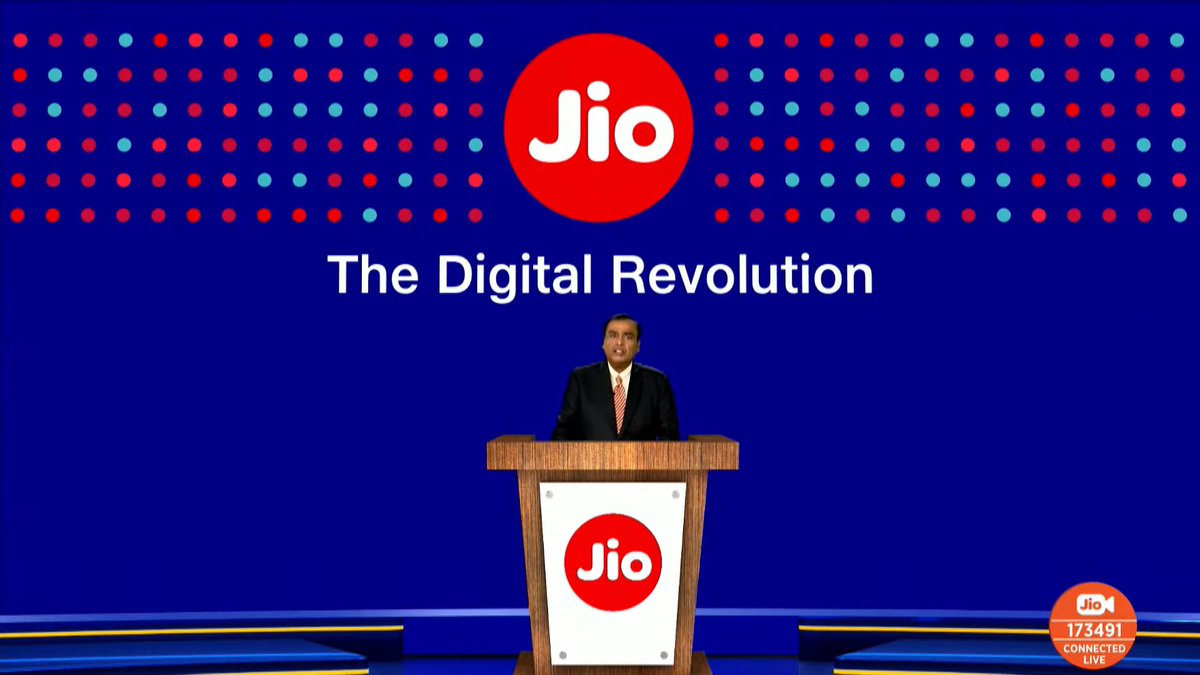"The idea of Jio was first seeded by Ambani’s daughter, Isha, in 2011. She was a student at Yale (in the US) and was home for holidays. She wanted to submit some coursework and she said, 'Dad, the internet in our house sucks'," he recalled.
Mega thread on how the India’s Largest Telecom Operator – Reliance Jio (~35% market share) came into existence & became India’s Largest Mobile Broadband in less than 2 years.
Crazy story...no less than revolution..
Please retweet and comment below if you got blown away..
(1/n)

"The idea of Jio was first seeded by Ambani’s daughter, Isha, in 2011. She was a student at Yale (in the US) and was home for holidays. She wanted to submit some coursework and she said, 'Dad, the internet in our house sucks'," he recalled.
What was that?
That big thing...that will change India forever...for good..
Ambani said - Akash, at that time, stated that in the old world, telecom was the voice and people made money on calls but in the new world everything is DIGITAL...!!
One simple but powerful idea..high speed internet is future
After the conversation, he researched more about it & found out that India was suffering from poor connectivity of data & prices were high which was not affordable to majority of Indians.
Dream was BIG...but it was game-changer...
After years of planning & research, Jio was finally launched on 5th September, 2016.
There was lot of competition...but Winning is their DNA..
It clicked...Indian customers loved it..
Digital revolution 2.0 in India just got started...
Digital Bharat..affordable cost..
Reliance Jio extended the free usage period for Jio services to its existing and new customers till March 31, 2017.
Jio reached the 100 million user mark in the first 170 days, adding consumers at an average of 600,000 a day.
It has been reported that around 6 million units of Jio Phone were booked within three days of its pre-booking that started on August 24.
And then came FIBER....yes...the new age gold.
They first announced as Jio GigaFiber in 2018 at the Reliance Industries 41st AGM. Later renamed Jio Fiber, it did commercial launch on September 5, 2019
This was truely a revolution..
How did it transform?
And this was just part of the game...
There was a bigger game..
So it's mobile + Broadband + OTT..
Truely - Karlo DIGITAL duniya mutthi mai..😀
Game-changing...
And market also rewarded it
Why not - it was thinking about FUTURE..
Yes...and the future is surely DIGITAL..
What it do to INDIA?

But one thing is for sure...it changed the DIGITAL landscape of INDIA forever..for good..
And transformed lives of crores of Indians
Hope you enjoyed this mega thread..
Connect with me here: https://t.co/bteXXhg269
More from Vivek Mashrani, CFA
You May Also Like
H was always unseen in S2NL :)
Those who exited at 1500 needed money. They can always come back near 969. Those who exited at 230 also needed money. They can come back near 95.
Those who sold L @ 660 can always come back at 360. Those who sold S last week can be back @ 301
Those who exited at 1500 needed money. They can always come back near 969. Those who exited at 230 also needed money. They can come back near 95.
Those who sold L @ 660 can always come back at 360. Those who sold S last week can be back @ 301
Sir, Log yahan.. 13 days patience nhi rakh sakte aur aap 2013 ki baat kar rahe ho. Even Aap Ready made portfolio banakar bhi de do to bhi wo 1 month me hi EXIT kar denge \U0001f602
— BhavinKhengarSuratGujarat (@IntradayWithBRK) September 19, 2021
Neuland 2700 se 1500 & Sequent 330 to 230 kya huwa.. 99% retailers/investors twitter par charcha n EXIT\U0001f602




















